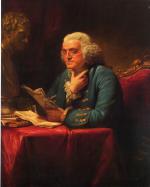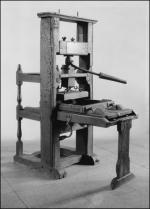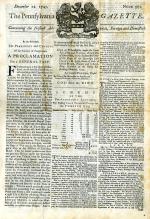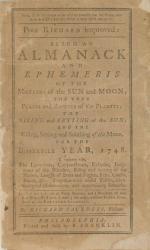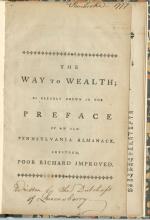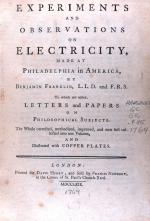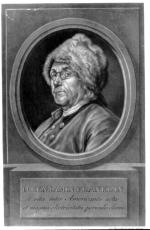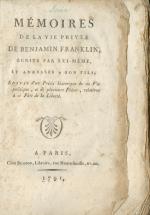![header=[Marker Text] body=[Printer, author, inventor, diplomat, philanthropist, statesman, and scientist. The eighteenth century's most illustrious Pennsylvanian built a house in Franklin Court starting in 1763, and here he lived the last five years of his life.] sign](http://explorepahistory.com/kora/files/1/10/1-A-3E6-139-benjamin%20franklin.jpg)
Mouse over for marker text
Name:
Benjamin Franklin [Power of Words: Writers and Publishers]
Region:
Philadelphia and its Countryside/Lehigh Valley
County:
Philadelphia
Marker Location:
Chestnut St. between 3rd & 4th Sts., Philadelphia
Dedication Date:
June 30, 1930
Behind the Marker
Given the multitude of job descriptions that history has attached to Benjamin Franklin, it’s particularly significant that the one he ascribed to himself was printer. In his own mind, he was first and foremost a man of ink and letters. He identified himself as such  in his Will , and he understood that so much of his good fortune and the opportunities that came from it grew out of his trade, and the ways in which he was able to use it. Colonial printers often became writers to give themselves more to print, and hence, more to sell. While some just put words on paper, others had something significant to say with the type that they set.
in his Will , and he understood that so much of his good fortune and the opportunities that came from it grew out of his trade, and the ways in which he was able to use it. Colonial printers often became writers to give themselves more to print, and hence, more to sell. While some just put words on paper, others had something significant to say with the type that they set.
And no one in eighteenth-century America had more to say more stylishly, wittily, satirically, and, when it most mattered, convincingly on subjects from indigestion to independence than Benjamin Franklin. He used his press skillfully and frequently. His ability to amuse drew Franklin a wide audience, and his ability to persuade helped create a new nation. Then, when he said most of what he needed to be said about what he had observed around him, he began to say much about what was within him. His landmark autobiography laid the foundation and erected the template for all would-be memoirists to follow.
Although Franklin’s formal education was short, he realized early how much he loved to read and write, teaching himself the latter by copying articles and essays that caught his fancy in publications like the British magazine The Spectator. In 1722, while apprenticed to his brother James, a printer in Boston, he began contributing bits of poetry—"wretched Stuff," Franklin later conceded—to The New-England Courant, the weekly newspaper that James published. Suspecting James would reject more substantial efforts, Franklin cloaked his identity in a pseudonym and, one by one, slipped a series of fourteen letters under the door of the printing house. Franklin used the novel persona of a busybody widow named Silence Dogood to criticize local society, from poetry and prostitution to Harvard and hoop petticoats with rollicking aplomb. At a precocious sixteen, Franklin had created the first of the many sensations his remarkable legacy would stand on.
He soon added other comic personae to his repertoire but also contributed news reports to The Courant before running away to Philadelphia in 1724. There, Franklin convinced Pennsylvania’s governor to send him across the Atlantic to pick up the requisite equipment and skills needed to launch a new newspaper in Philadelphia. In London the following year, he wrote and published two harbingers of things to come: a long philosophical essay called "A Dissertation on Liberty and Necessity, Pleasure and Pain," the first serious glimpse into the mind of one of the architects of American freedom, and the brief "Plan of Conduct" in which Franklin states a few guiding principles that would later emerge more pithily through the pen of Franklin’s most popular literary persona, the Poor Richard driven by his wife and his poverty to compile an almanac.
"Plan of Conduct" in which Franklin states a few guiding principles that would later emerge more pithily through the pen of Franklin’s most popular literary persona, the Poor Richard driven by his wife and his poverty to compile an almanac.
Back in Philadelphia, Franklin opened his own print shop a year later, and began disseminating his thoughts on politics, marriage, money, science, and philosophy in voices ranging from the compassionate friend to the outraged citizen. Using the pseudonym "The Busy-Body," Franklin mercilessly satirized a new publication, The Pennsylvania Gazette, launched in 1728 by Samuel Keimer, his former employer; in 1729, Franklin bought the journal, and immediately transformed it into a lively paper. As Franklin’s bully pulpit became the most widely read periodical in the colonies, his voice became more and more influential, and the reputation of his inquisitive mind grew.
In 1732, Franklin began a twenty-six-year run of publishing Poor Richard’s Almanack. With a circulation eventually reaching 10,000, its compendium of weather forecasts, household hints, astronomical and astrological insights, puzzles, poems and Franklin’s uncanny gift for churning aphorisms, it became America’s most popular annual publication. His maxims—some original and some adapted—seeped into the common consciousness, where they remain to this day, shimmering in wit, shining in wisdom, and sometimes dripping in their cynicism.
"Early to bed and early to rise, makes a man healthy, wealthy and wise."
"Three keep it a secret if two of them are dead."
"Necessity never made a good bargain."
"A penny saved is a penny earned."
"Lost time is never found again."
"Eat to live, and not live to eat."
"Haste makes waste."
"Love your Neighbor; yet don’t pull down your hedge."
"God heals and the doctor takes the fee."
"He that lives upon hope will die fasting."
Beyond the almanac and Gazette, Franklin’s presses hummed with pamphlets, treatises, parables, editorials, and humorous bagatelles of his devising. He wrote about religion, education, his own scientific experiments, including the flight of his famous kite. In the months before he retired from his printing business in 1748, he drew on his persuasive skills to convince Pennsylvania’s Assembly to establish a militia against the encroaching French. Ten years later, he prefaced the final edition of the almanac with a fictional tale built around his proverbs on thrift, money and industry. In the nineteenth century, it would be republished as
famous kite. In the months before he retired from his printing business in 1748, he drew on his persuasive skills to convince Pennsylvania’s Assembly to establish a militia against the encroaching French. Ten years later, he prefaced the final edition of the almanac with a fictional tale built around his proverbs on thrift, money and industry. In the nineteenth century, it would be republished as  The Way to Wealth.
The Way to Wealth.
In 1757, Franklin went to London, where he wrote spirited defenses of American life. He remained abroad for five years but was back in London by 1765 to oppose the Stamp Act. Over the next decade, his writings on politics grew sharper and his written attacks on British injustices toward the colonies became more pointed, culminating in a brilliant and biting 1773 satire called "An Edict by the King of Prussia" designed to make the British understand what their own prejudices felt like.
"An Edict by the King of Prussia" designed to make the British understand what their own prejudices felt like.
Back in Philadelphia, as a delegate to the Second Continental Congress, Franklin was part of the committee that helped draft The Declaration of Independence, and he made several editorial changes to Thomas Jefferson’s original draft. Then, as the new nation’s first Minister to France from 1776 to 1785, he continued to plead the cause of his new nation abroad in political satires, bagatelles, pamphlets and letters. Indeed, throughout his life, Franklin was a voluminous correspondent on a variety of subjects.
In 1771, while still in London, Franklin began what would become his most significant achievement as a writer: his autobiography, one of the true benchmarks of American literature. Written in four parts over four different periods (1771, 1784, 1788, and 1788–1789) and heavily revised throughout his life, Franklin recounts his story from his youth in Boston through his arrival in London in 1757. The first part. conceived as a long letter to his illegitimate son, William, the last Loyalist governor of New Jersey, uses Franklin’s rise from an apprentice to his brother to his founding of the Philadelphia Library Company in 1731 to espouse the importance of virtue and hard work. The second section, which Franklin wrote in Paris, focuses on what he deemed the "bold and arduous project of arriving at moral Perfection," and cites the
first part. conceived as a long letter to his illegitimate son, William, the last Loyalist governor of New Jersey, uses Franklin’s rise from an apprentice to his brother to his founding of the Philadelphia Library Company in 1731 to espouse the importance of virtue and hard work. The second section, which Franklin wrote in Paris, focuses on what he deemed the "bold and arduous project of arriving at moral Perfection," and cites the  13 famous virtues. that he would have to embrace on that unfinishable journey. The third and very brief fourth parts, written shortly before Franklin’s death in 1790, describe how the adult Franklin adopted the virtues he learned in the first part and explored in the second to become a prosperous man of substance and an important contributor to the evolving world of art, politics, and philanthropy.
13 famous virtues. that he would have to embrace on that unfinishable journey. The third and very brief fourth parts, written shortly before Franklin’s death in 1790, describe how the adult Franklin adopted the virtues he learned in the first part and explored in the second to become a prosperous man of substance and an important contributor to the evolving world of art, politics, and philanthropy.
Despite the emphasis on good works, good deeds, and good attitude, Franklin paints himself from beginning to end very much the way contemporary accounts of his life paint him: personable, gregarious, approachable, and flawed—in short, a man, not a monument. A great man, to be sure, but a man of flesh, not marble. This is perhaps the book’s lasting appeal.
First published in part in France—in French, in 1791, and then in English, in London, two years later—parts one, two and three finally appeared together, in the United States, as Memoirs of the Life and Writings of Benjamin Franklin, in 1818. Amazingly, though, until English professor Paul Zall discovered a heavily annotated copy at the Huntington Library in San Marino, California, in the 1950s, we did not know the last thoughts that Franklin lavished on his masterpiece. The University of Tennessee Press first published this comprehensive version in 1981. Now called simply The Autobiography of Benjamin Franklin, the book has gone on to become the most widely translated work of American nonfiction ever published.
And no one in eighteenth-century America had more to say more stylishly, wittily, satirically, and, when it most mattered, convincingly on subjects from indigestion to independence than Benjamin Franklin. He used his press skillfully and frequently. His ability to amuse drew Franklin a wide audience, and his ability to persuade helped create a new nation. Then, when he said most of what he needed to be said about what he had observed around him, he began to say much about what was within him. His landmark autobiography laid the foundation and erected the template for all would-be memoirists to follow.
Although Franklin’s formal education was short, he realized early how much he loved to read and write, teaching himself the latter by copying articles and essays that caught his fancy in publications like the British magazine The Spectator. In 1722, while apprenticed to his brother James, a printer in Boston, he began contributing bits of poetry—"wretched Stuff," Franklin later conceded—to The New-England Courant, the weekly newspaper that James published. Suspecting James would reject more substantial efforts, Franklin cloaked his identity in a pseudonym and, one by one, slipped a series of fourteen letters under the door of the printing house. Franklin used the novel persona of a busybody widow named Silence Dogood to criticize local society, from poetry and prostitution to Harvard and hoop petticoats with rollicking aplomb. At a precocious sixteen, Franklin had created the first of the many sensations his remarkable legacy would stand on.
He soon added other comic personae to his repertoire but also contributed news reports to The Courant before running away to Philadelphia in 1724. There, Franklin convinced Pennsylvania’s governor to send him across the Atlantic to pick up the requisite equipment and skills needed to launch a new newspaper in Philadelphia. In London the following year, he wrote and published two harbingers of things to come: a long philosophical essay called "A Dissertation on Liberty and Necessity, Pleasure and Pain," the first serious glimpse into the mind of one of the architects of American freedom, and the brief
Back in Philadelphia, Franklin opened his own print shop a year later, and began disseminating his thoughts on politics, marriage, money, science, and philosophy in voices ranging from the compassionate friend to the outraged citizen. Using the pseudonym "The Busy-Body," Franklin mercilessly satirized a new publication, The Pennsylvania Gazette, launched in 1728 by Samuel Keimer, his former employer; in 1729, Franklin bought the journal, and immediately transformed it into a lively paper. As Franklin’s bully pulpit became the most widely read periodical in the colonies, his voice became more and more influential, and the reputation of his inquisitive mind grew.
In 1732, Franklin began a twenty-six-year run of publishing Poor Richard’s Almanack. With a circulation eventually reaching 10,000, its compendium of weather forecasts, household hints, astronomical and astrological insights, puzzles, poems and Franklin’s uncanny gift for churning aphorisms, it became America’s most popular annual publication. His maxims—some original and some adapted—seeped into the common consciousness, where they remain to this day, shimmering in wit, shining in wisdom, and sometimes dripping in their cynicism.
"Early to bed and early to rise, makes a man healthy, wealthy and wise."
"Three keep it a secret if two of them are dead."
"Necessity never made a good bargain."
"A penny saved is a penny earned."
"Lost time is never found again."
"Eat to live, and not live to eat."
"Haste makes waste."
"Love your Neighbor; yet don’t pull down your hedge."
"God heals and the doctor takes the fee."
"He that lives upon hope will die fasting."
Beyond the almanac and Gazette, Franklin’s presses hummed with pamphlets, treatises, parables, editorials, and humorous bagatelles of his devising. He wrote about religion, education, his own scientific experiments, including the flight of his
In 1757, Franklin went to London, where he wrote spirited defenses of American life. He remained abroad for five years but was back in London by 1765 to oppose the Stamp Act. Over the next decade, his writings on politics grew sharper and his written attacks on British injustices toward the colonies became more pointed, culminating in a brilliant and biting 1773 satire called
Back in Philadelphia, as a delegate to the Second Continental Congress, Franklin was part of the committee that helped draft The Declaration of Independence, and he made several editorial changes to Thomas Jefferson’s original draft. Then, as the new nation’s first Minister to France from 1776 to 1785, he continued to plead the cause of his new nation abroad in political satires, bagatelles, pamphlets and letters. Indeed, throughout his life, Franklin was a voluminous correspondent on a variety of subjects.
In 1771, while still in London, Franklin began what would become his most significant achievement as a writer: his autobiography, one of the true benchmarks of American literature. Written in four parts over four different periods (1771, 1784, 1788, and 1788–1789) and heavily revised throughout his life, Franklin recounts his story from his youth in Boston through his arrival in London in 1757. The
Despite the emphasis on good works, good deeds, and good attitude, Franklin paints himself from beginning to end very much the way contemporary accounts of his life paint him: personable, gregarious, approachable, and flawed—in short, a man, not a monument. A great man, to be sure, but a man of flesh, not marble. This is perhaps the book’s lasting appeal.
First published in part in France—in French, in 1791, and then in English, in London, two years later—parts one, two and three finally appeared together, in the United States, as Memoirs of the Life and Writings of Benjamin Franklin, in 1818. Amazingly, though, until English professor Paul Zall discovered a heavily annotated copy at the Huntington Library in San Marino, California, in the 1950s, we did not know the last thoughts that Franklin lavished on his masterpiece. The University of Tennessee Press first published this comprehensive version in 1981. Now called simply The Autobiography of Benjamin Franklin, the book has gone on to become the most widely translated work of American nonfiction ever published.




